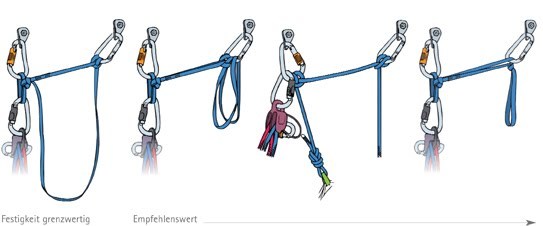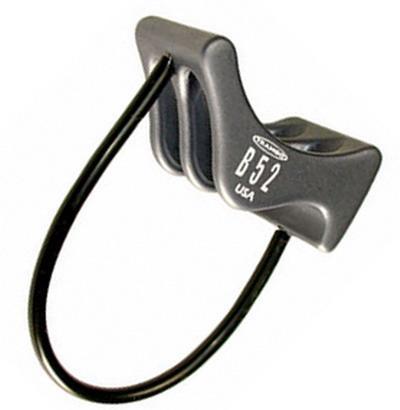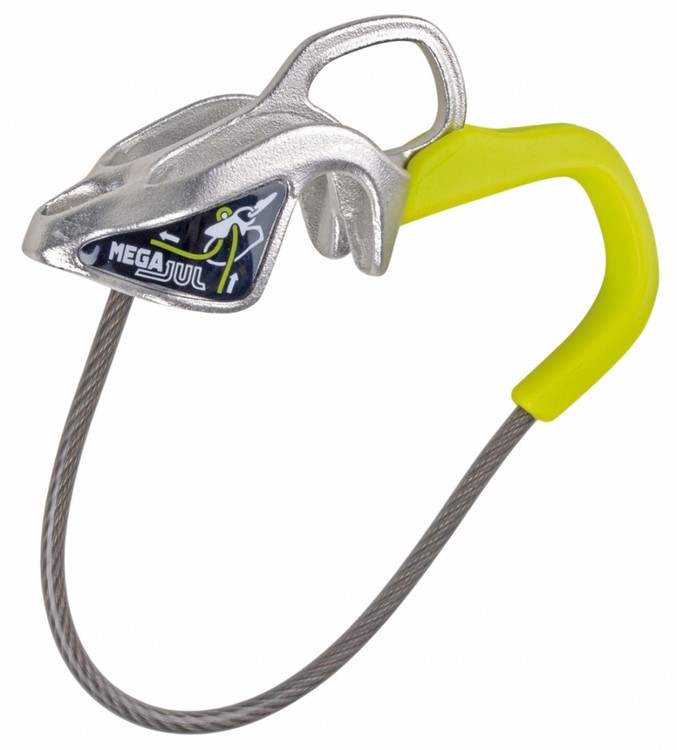Belay Anchor "In Series" - "Weiches Auge": Why don't I see this in American tutorials?
|
|
Hey folks, I am just getting into multi-pitch climbing and have been doing a lot of reading/watching on anchor building. I live in Germany and went out with my buddy who showed me a method for building an anchor with at least one really solid bolt, in which a bowline on a bight (called a weiches Auge in German) is clipped into the lower bolt (or more solid if they are horizontally placed) and the long end of the sling is tied into the carabiner on the second bolt with a clove hitch, without extra slack but not under load. The bowline loop is used then as the master point. Ortovox describes this method here: https://www.ortovox.com/uk/safety-academy-lab-rock/chapter-3-belay-stations-and-belay-techniques/belay-stations And this ENSA video describes it as well: https://www.youtube.com/watch?v=eqZQnCGl24A And this mountain project post asks about some clipping technique with this kind of anchor, but doesn't address the series method in itself: https://www.mountainproject.com/forum/topic/118123835/direct-belay-off-of-series-anchor-variations I've also read about it in a modern alpine climbing manual in German, so it seems like a pretty legit method for building a belay anchor. My question is this: Why did I never come across this technique while watching anchor building tutorials from North America? Every video I've watched stresses equalization as an essential anchor building parameter, and this series method has zero equalization - all of the load is placed on the main bolt. Some advantages seem to me to be speed in building the anchor with a prepared sling that can be re-used, and that the system being non-equalized, there is no concern about the direction of load changing. Otherwise the anchor is still redundant, it is very efficient, and has low extension. Any clarification/insight would be appreciated. Drawing from https://www.mymountains.de/standplatzbau |
|
|
I believe this is a "banshee belay." Never used it, but here's some discussion on it: https://people.bath.ac.uk/dac33/high/6TheBelay.htm#bansheebelays https://www.mountainproject.com/forum/topic/118790818/banshee-belayfixed-point-belay-question I think it's more of a European practice.. |
|
|
We have been connecting ice screws in a series like this forever. |
|
|
My impression is that distribution of the load among anchor points (of which equalization is a special case describing equal distribution among equally solid components) has always had a special place in American anchor building practice, sometimes with more importance relegated to it than removing extension from the rigging. The German and Italian alpine clubs have not had such hang ups and for the last 20+ years have explored alternative anchor building paradigms including the series belay you've noted here (often referred to as a "banshee belay" in English). This rigging is particularly important for fixed point belaying (occasionally called "direct anchor belaying"), in which a leader is belayed directly from the anchor. This is described in the ENSA video linked in the OP. There is also testing (most of it not in English) that indicates that eliminating extension is likely the more important goal in anchor rigging than load distribution, which is often imperfect at best, though this assumes components are unquestionably solid and redundancy has already been achieved when necessary. |
|
|
Patrick Faurot wrote: Like others have said, this technique has been discussed on MP. The ACMG had a video on Vimeo on this technique, but for some reason it is no longer there. I think in general, a lot of people (not all) are quite resistant to new things. How many times have you seen someone post a new method on MP, and most people's first reaction is "but I've always done it this other way and it's great", or even "I've never seen that and therefore it's not good". Very few people keep an open mind about new methods. |
|
|
aikibujin wrote: I certainly don't disagree, though I think it's a bit more nuanced situation in climbing. The mentality of, "If it ain't broke, don't fix it," can have a lot of value in a sport where the risk of failure is death. Consequently, new methods are likely to be met with understandable and often justified skepticism as a new system can introduce various unforeseen negative externalities. That said, we always seem to be a decade or two behind European systems and research here in the U.S. I started using the fixed point belay in 2012 when I first learned about it, having seen the research and tutorials. It took another few years for it to start really showing up on MP, and a few more years still for it to appear in English language videos, articles, etc. (ACMG video being an exception). I wonder as well if resistance to new methods stems from rule-based understanding of climbing systems. If one hasn't advanced to a principled understanding of the systems presently employed, it's difficult to evaluate the pros and cons of a new technique. |
|
|
I used to guide for a handful of years (in the US) and have used many different anchor set ups. I still climb regularly and travel internationally for climbing. I have never seen this anchor/belay method used. I understand the idea but what is the specific benefit? |
|
|
Americans broadly have a misguided obsession with equalization. I’m not sure why. Maybe because we have a history of building gear anchors with crappy placements, and have fewer bolted anchors than the Euros. |
|
|
When anchors on classic beginner climbs consist of quarter inch bolts placed by Warren Harding, small bushes, and a good foot brace, it is easier to avoid confusion and teach one system. |
|
|
Derek DeBruin wrote: I don't know. Most of the time I've seen this "if it ain't broke, don't fix it" mentality it's used to dismiss anything new out of hand. A better mentality should be skeptical curiosity. You're right, the risk of failure is very high, so obviously I wouldn't totally commit to a new way just because it's new and exciting. I try to understand a new method, analyze it, do some garage testing, try to see the pro and con, practice it, and then try it out in a low consequence environment. Innovation comes from the curiosity of new possibilities, instead of that "don't fix it" mentality. Years ago I had a Trango B-52 belay device. In using it, I found that the bottom curve of the device sometimes push a round-stock biner against the rope and pinching it when I try to yard out slack fast, preventing a smooth feed. I actually emailed Trango about this problem and suggested that they smooth out the bottom to fix it. Then years later, the Euros came out with belay devices with more aggressive bottom curve that's designed to force the belay biner into the rope and pinching it. Had I been more open to new possibilities, maybe I could have seen this new design. |
|
|
aikibujin wrote: It was deliberately made that way by Trango, as was the Metolouis BRD (which had a thunb tab to help fast feeding and lowering) and of course the Wild Country device. The principle had already been developed with the Salewa Antz in the 1970's, there's nothing new in the design of the Edelrid thingies. |
|
|
aikibujin wrote: yeah but most of the new methods are just someone trying to come up with some horseshit redundancy that doesnt really add benefit, and instead adds confusion and complexity |
|
|
I belay this way on straightforward multi-pitch 2-bolt belays. Works great when using a piece of skinny rope as a tether - one locker on an eight at the end and another on a clove (or kong slyde) in the middle. Never seen a faster or more efficient way tbh. Also allows fast rapping. |
|
|
Thanks for all of the insight. I'm also curious about AlecBerg's question about the specific benefits of setting up in series like this. Is it mostly just speed and simplicity assuming a really solid bolt? Is not worrying about equalization an advantage? With a fixed point belay, does the reduced range of displacement of the master point reduce force on the bolt? Alec Berghoef wrote: |
|
|
Alec Berghoef wrote: (Edit: the rigging in the OP supports both direct belay of a second off the anchor, and with more or less additional rigging, fixed-point belays for the leader. Advantage of FP belays below). 1. Belayer protection by removing them from the system (i.e. belayer doesn’t move on hard falls or in caves); 2. Protected belayer is more likely to control rope on hard falls, protecting the climber; 3. Potentially reduced forces reported (ENSA) depending on belay technique. |
|
|
its just another tool in the toolbox. no more and no less.... |
|
|
These aren't new methods. But whatever. |
|
|
Sometimes I clip the guide orienting 'biner directly to a bolt. The horror. Bolt is either connected via chain or I add a draw to connect to the other bolt. Not my pic: |
|
|
Patrick Faurot wrote: not sure about the 'soft eye,' but 'series' anchors have been around forever. if i recall correctly there is a famous picture of some A4 or 5 horror show on the SE face of el cap that shows a bunch of horizontal rurps etc. in a series anchor. i don't use this type of anchor frequently (and can't imagine why you'd use it on a bolted belay), but i do use it infrequently with gear/natural anchors. imho it works best with a single vertical or near vertical (frontal plane) crack where the anchor placements aren't that great and rather far apart. |
|
|
aikibujin wrote: I agree, which I tried (but I suppose failed) to convey in my follow up in the rest of my post. I do the same: analyze based on principles, try it out, read the research if available/applicable, etc. However, many folks don't. And I'd venture that a large number of climbers lack the necessary background knowledge to do so, hence rules. But I agree this stifles innovation and potential progress. |
|
|
I loved my B52! My friend dropped it 8 years ago. I had the same problem, so I would flip it around to the other side. |

 Continue with onX Maps
Continue with onX Maps Continue with Facebook
Continue with Facebook




























